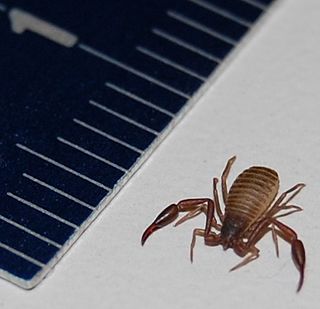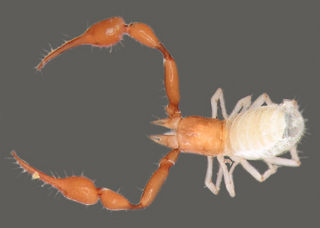
Pseudoscorpions, also known as false scorpions or book scorpions, are small, scorpion-like arachnids belonging to the order Pseudoscorpiones, also known as Pseudoscorpionida or Chelonethida.

Chernetidae is a family of pseudoscorpions, first described by Anton Menge in 1855.

Olpiidae is a family of pseudoscorpions in the superfamily Garypoidea. It contains the following genera:

Garypus is a genus of pseudoscorpions in the family Garypidae. It was described by German arachnologist Ludwig Carl Christian Koch in 1873. The species are found mainly in tropical and subtropical areas, where they occupy supralittoral and littoral zones in seashore habitats.

Cheliferidae is a family of pseudoscorpions in the order Pseudoscorpiones, first described by Antoine Risso in 1827.

Syarinidae is a family of pseudoscorpions in the order Pseudoscorpiones. There are at least 20 genera and 110 described species in Syarinidae.
Hesperochernes is a genus of pseudoscorpions in the family of Chernetidae.
Ideoroncidae is a family of pseudoscorpions belonging to the order Pseudoscorpiones. Members of the family are known from Asia, Africa, western North America and South America.

Withiidae is a family of pseudoscorpions, first described by Joseph Conrad Chamberlin in 1931.
Lagynochthonius is a genus of pseudoscorpions in the family Chthoniidae. It was described in 1951 by Austrian arachnologist Max Beier.

Tyrannochthonius is a genus of pseudoscorpions in the family Chthoniidae. It was described in 1929 by American arachnologist Joseph Conrad Chamberlin.
Ideoblothrus is a genus of pseudoscorpions in the Syarinidae family. It was described in 1892 by Italian naturalist Luigi Balzan as a subgenus of Ideobisium.
Americhernes mahnerti is a species of pseudoscorpion in the Chernetidae family. It is endemic to Australia. It was described in 1990 by Australian arachnologist Mark Harvey. The specific epithet mahnerti honours Austrian zoologist Volker Mahnert (1943–2018) for his work on pseudoscorpions.
Americhernes muchmorei is a species of pseudoscorpion in the Chernetidae family. It is endemic to Australia. It was described in 1990 by Australian arachnologist Mark Harvey. The specific epithet muchmorei honours American arachnologist William Muchmore (1920–2017) who described the genus Americhernes.
Americhernes orestes is a species of pseudoscorpion in the Chernetidae family. It is endemic to Australia. It was described in 1990 by Australian arachnologist Mark Harvey. The specific epithet orestes refers to the species’ presence on one of Queensland's highest mountains.
Americhernes neboissi is a species of pseudoscorpion in the Chernetidae family. It is endemic to Australia. It was described in 1990 by Australian arachnologist Mark Harvey. The specific epithet neboissi honours Latvian-Australian entomologist Arturs Neboiss (1924–2010) who collected the holotype.
Cordylochernes dingo is a species of pseudoscorpion in the Chernetidae family. It is endemic to Australia. It was described in 1990 by Australian arachnologist Mark Harvey. The specific epithet dingo refers to the type locality.
Haplochernes is a genus of pseudoscorpions in the Chernetidae family. It was described in 1932 by Austrian arachnologist Max Beier.
Paraliochthonius is a genus of pseudoscorpions in the Chthoniidae family. It was described in 1956 by Austrian arachnologist Max Beier.







